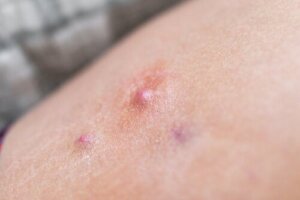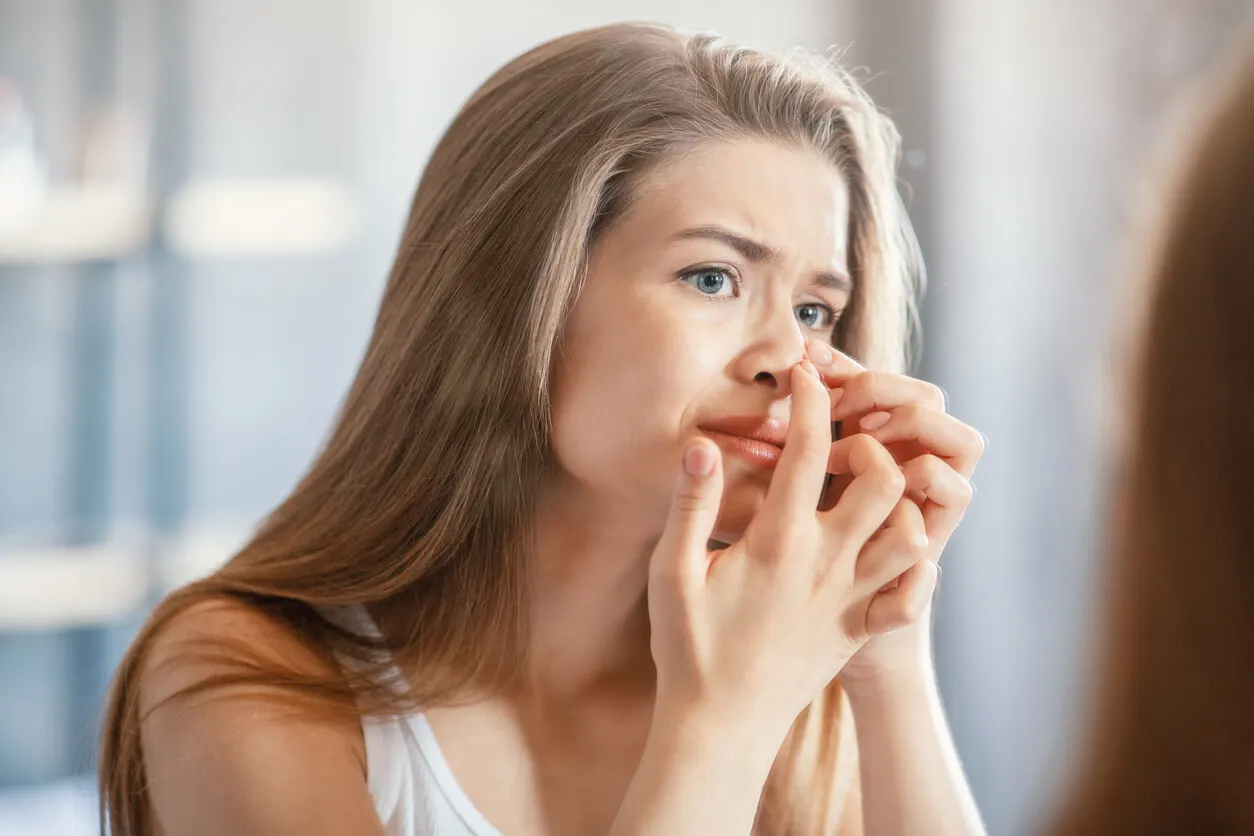Why Is it Bad to Burst Hidradenitis Suppurativa Lumps?

Hidradenitis suppurativa is a chronic condition. Its main manifestation is painful lumps that form under the skin, when the hair follicles become obstructed. The causes are unknown, although there are associated risk factors, such as obesity. Find out why you shouldn’t burst hidradenitis suppurativa lumps in this article.
And, although there’s no cure, there are various treatments that are applied to reduce the symptoms and improve the patient’s quality of life. Also, some precautions can be taken to prevent outbreaks, avoiding triggers.
On the other hand, it should be noted that it isn’t advisable to burst hidradenitis suppurativa lumps. This could lead to infections, among other problems.
What are the symptoms of hidradenitis suppurative?
The estimated incidence of hidradenitis suppurativa varies from region to region. According to some research, between 1 and 4% of the population has this condition. Other sources report 1 case per 300 people.
It’s more common in men, and is also seen more frequently in obese or overweight people and smokers. It can start from puberty until the age of 40. With age, the incidence decreases.
Also known as acne inversa, it’s a chronic disease that affects the hair follicles. Its main manifestation is lumps that form under the skin, which are usually painful and filled with pus. These abscesses may have rounded holes, but without a central point, as is the case with boils.
The lumps appear in areas with a large number of sebaceous and sweat glands, especially where the skin rubs against the skin. The most common locations are as follows:
- Armpits
- Buttocks or perianal areas
- Groin area
- Submammary area
Other symptoms include itching, redness, tenderness, and swelling. The lumps, when opened, may produce pus with a foul odor.
This disease is neither contagious nor sexually transmitted; nor is it due to poor hygiene.
It isn’t clear what the cause may be. There are associated risk factors, such as nicotine and obesity. Regarding the latter, it’s hypothesized that heavier people have more skin-to-skin friction.
Also, other medical conditions may be present in patients with hidradenitis suppurativa:
- Acne
- Diabetes
- Dissecting cellulitis
- Crohn’s disease
- Polycystic ovary syndrome

Read more here: Can Diet Improve Hidradenitis Suppurativa?
How can it be treated?
There’s no cure for hidradenitis suppurativa. However, early diagnosis helps prevent it from getting worse.
Medical management options include the following:
- Light therapies
- Retinoids to combat associated acne
- Surgical drainage of abscesses
- Corticosteroids to reduce pain and inflammation
- Anti-inflammatory drugs, such as ibuprofen or naproxen
- Antibiotics (oral or topical): amoxicillin, tetracycline, erythromycin
- Birth control pills (when there are hormonal problems or polycystic ovary syndrome)
Other skin care
In addition to the above treatments, the patient with hidradenitis suppurativa can use the following advice and measures, always in consultation with the physician:
- Wearing loose clothing to avoid chafing
- Staying at the right weight
- Placing warm compresses on the affected area
- Applying topical cleansing products (antibacterial and antiseptic)
- Avoiding alcohol wipes
- Being careful when shaving
- Using laser hair removal techniques
Be sure to read: Symptoms of Seborrheic Dermatitis and Treatment
Why is it bad to burst hidradenitis suppurativa lumps?
The discomfort created by the disease can become intolerable. Because of this, some patients take the initiative to burst hidradenitis suppurativa.
Although sometimes the pressure of sitting or applying a compress may cause the lumps to rupture on their own, it isn’t recommended that you actively burst them.
It’s true that it does relieve pain and tension. However, there’s a serious risk of infection, as bacteria may be present on the skin or hands when the hidradenitis suppurativa lumps burst.
Moreover, continued healing and scarring causes the affected area to thicken, and become stiff and hard to the touch. The aesthetic appearance is altered.
In addition, fistulas may form, which are hollow spaces or passages in the tissue. These cause pain and require a surgical procedure to repair.
As mentioned above, all of these situations can occur naturally when suffering from hidradenitis suppurativa. However, bursting the lumps tends to aggravate the problem.

Other complications
When we choose to burst hidradenitis suppurativa lumps, several general complications may occur. Among them we have the following:
- Coalescence of fistulas, with the destruction of subcutaneous tissue
- Chronic ulcers
- Chronic lymphedema
It has also been reported that the trauma caused can alter the skin cells. In the long term, but not always, squamous cell carcinoma or mucosecretory adenocarcinoma may develop in the deeply scarred areas.
Better to prevent and not burst hidradenitis suppurativa lumps
Prognosis varies with severity, as well as with treatment and lifestyle. In some people, there may be recurrent flare-ups throughout their lives. In others, the disease improves with drugs or surgery. It may also go into remission on its own.
Since the causes of hidradenitis suppurativa aren’t clearly known, neither is it possible to know if it can be prevented. At most, it’s possible to avoid aggravating flare-ups or certain complications.
In this regard, caution should be exercised with both the products used and clothing, avoiding clothing that generates friction or rubbing. The latter doesn’t necessarily refer to tight clothes, but rather to those that don’t fit well.
It’s also recommended to always maintain an adequate weight, good hygiene of the affected areas, and to avoid smoking. Last but not least, don’t touch the lumps or apply pressure to burst them.
All cited sources were thoroughly reviewed by our team to ensure their quality, reliability, currency, and validity. The bibliography of this article was considered reliable and of academic or scientific accuracy.
- Achenbach R, Greco C. Hidradenitis supurativa. Rev. argent. dermatol. 2013; 94(4): 6-10.
- Arena G, Maradeo R, Michelena M, et al. Hidradenitis supurativa con transformación carcinomatosa. Med. cután. ibero-lat.-am. 2012; 40(6): 184-190.
- García-Martínez F, Pascual J, López-Martín I, et al. Actualización en hidrosadenitis supurativa en Atención Primaria. SEMERGEN – Medicina de Familia. 2017; 43(1): 34-42.
- Gracia Cazaña L, Berdel Díaz J, Martín Sánchez I, et al. Systematic Review of Light-Based Treatments for Hidradenitis Suppurativa. Actas Dermo-Sifiliográficas. 2020; 111(2): 89-106.
- Martorell F, García D, Jiménez-Gallo J, et al. Update on Hidradenitis Suppurative (Part II): Treatment Actas Dermo-Sifiliográficas. 2015; 106(9): 716-724.
- Martorell A, Caballero Y, González Lama D, et al. Manejo del paciente con hidradenitis supurativa, Actas Dermo-Sifiliográficas. 2016; 107(2): 32-42.
- Shahi V, Alikhan A, Vazquez B, Weaver A, Davis M. Prevalence of hidradenitis suppurativa: A population-based study in Olmsted County, Minnesota. Dermatology. 2014; 229: 154-158.
This text is provided for informational purposes only and does not replace consultation with a professional. If in doubt, consult your specialist.








